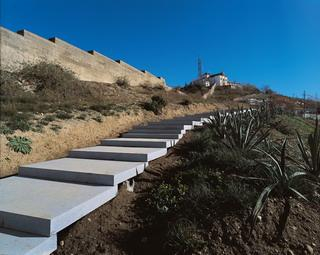Intervention on Nasrid Wall and Surroundings
Opposite the hill on which the Alhambra and the Generalife stand, the Cerro de San Miguel frames the last stretch of the Valle del Darro and its fertile lowland Vega. This wild, natural landscape, despite its proximity to and close links with the city, has nonetheless become a residual, almost marginal space. An area of transition towards the new city which, in the midst of its disorder, brushes lightly against the incomplete, fractured remains of the Nasrid wall.
The significance of what was once a defensive and organisational limit of the city has changed entirely, yet it continues to serve as a reader s guide to an urban model. The project preserves this landscape, essential to an understanding of the city in the context of the mountainous structure by which it is regulated.
Perfectly visible from the Alhambra, the northern stretch of
the Nasrid wall, built early in the 14th century, had contained a 40-metre breach since the 19th century. The purpose of restoring the wall, which constituted the second phase of the project, was to endow this stretch with visual continuity, redefine the lost historical limit and protect the original remains. Seen from a distance, the new section melds with the rest, respecting its linear sequence; when viewed close up, however, it is strikingly different from the original wall.
This intervention closes the breach with an outer dressing that
adapts strictly to its thickness without touching the historical remains, thereby guaranteeing their optimum conservation. 112 m? of granite were piled up: large untreated stones of standard section and length - the most economical - placed on a bed buried under the ground. The idea was to create the sensation of piled-up material gathered together with the aim of further emphasising, if necessary, the permanent, historical nature of the monument.









.jpg)
